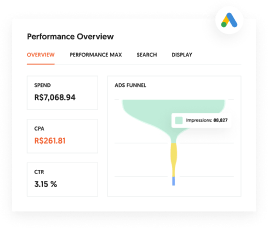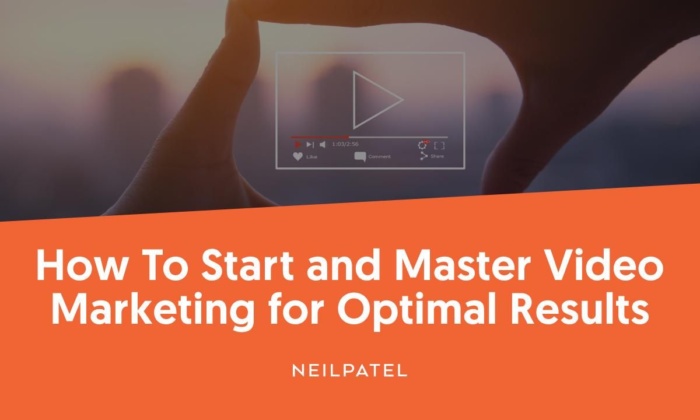
Do you know one of the best ways to engage prospects and build brand awareness? By using the power of video marketing.
If you’ve been dreaming about organic lead generation and building personal connections with your customers, creating video content could be the solution you are looking for.
How?
Let’s take a look at the statistics.
According to a recent video marketing statistics report from Wyzowl, over 80 percent of marketers surveyed attribute video to an increase in lead generation and sales:
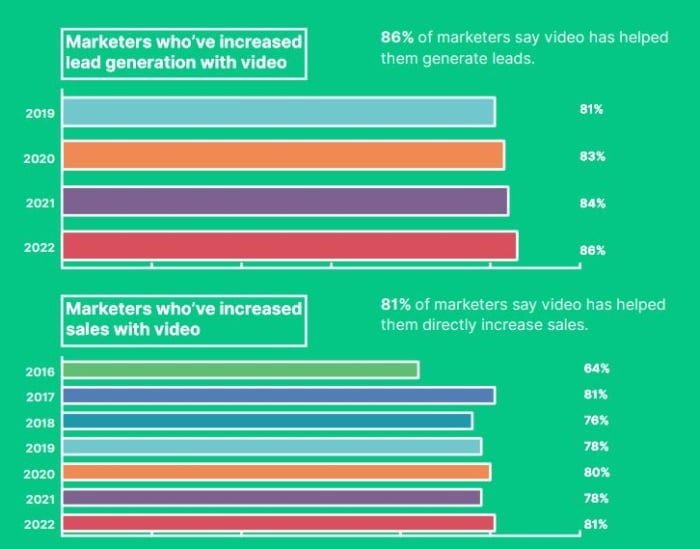
Businesses and marketers alike have taken note of these video marketing trends. They are creating new marketing materials for their websites, email outreaches, social media, and even “OTT” video adverts on streaming platforms.
Why?
Audience preference, mainly. After all, video content is easy to consume.
Videos also create a welcome break from the “overabundance of textual information online.” Why? Because they provide a more engaging and dynamic way for viewers to consume content, making information easier to digest while breaking up long blocks of text. These are just some of the benefits of video marketing.
Creating video content can seem intimidating for any smaller company with a low budget.
I understand that.
You cannot leap into successful video marketing blindly, so what do you do?
Well, you start by understanding the process behind successful video marketing campaigns to avoid costly mistakes.
You also need a firm grasp of video marketing trends and the right video marketing tools to create professional-looking visual content easily.
That’s what I’m talking about today, so let’s get to it.
Getting Started With Video Marketing
Video marketing is at an all-time high, with 96 percent of marketers stating it’s an “important part” of their strategy. Ninety-two percent also say video marketing gives them a positive ROI.
It’s easy to see its popularity, isn’t it?
In this section, I’ll cover some tips and tricks to get started with video marketing and see results.
1. Create a Plan, Set Goals, and Measure Them
As with any successful marketing campaign, you must start with a plan.
Holding your mobile phone, pointing it in the right direction, and clicking “record” might feel instinctual – but a lot more work goes on behind the scenes of video content.
Having a plan helps you slow down, breathe, and gives you focus.
Additionally, a plan helps you maximize your outreach by posting your video in the right places.
If you play your cards right, you might even see some of your videos go viral.
Also, instead of losing progress on a day when you are feeling flat and uninspired, a plan can:
- help you structure content ideas
- ensure you have the right video marketing tools
- and allow you to schedule a time to edit your footage before posting
This considerably improves the quality of your video marketing content.
Next, you need to make goals based on your plan – and keep track of measurable results.
Consider this: how would you define success?
More sales? A higher CTR? Better engagement on your social media posts?
Take a look at these SMART goals. SMART is a universally recognized system for creating measurable, trackable, and attainable goals.
If that’s too intense, here’s a condensed cheat sheet version for your business:
Remember: don’t just make goals, but actually hold yourself accountable for them.
If you started creating video content today, and six months from now, you had no definitive idea of the future direction of your content, I’d suggest that your campaign was in serious trouble.
Achieving consistent growth with video marketing comes down to two things:
1). Finding what works and recreating it in future videos.
2). Finding what doesn’t work and ensuring it’s not in your future videos.
These are the absolute basics of consistently increasing the effectiveness of your video content.
2. Stick With What You Know
When you draft your action plan, it’s usual to bounce around some video marketing ideas for upcoming content or even create a full strategy.
However, the best approach is to stick with what you know.
For instance, if you’ve been creating educational content on your blog, your best bet would be to start with educational video content and see if that resonates with your audience in the same way.
So many companies are trying so hard to innovate that they ignore the tried-and-tested content types that already work.
Trying to come up with brilliant video marketing ideas and then executing them poorly could harm your future video marketing efforts.
To narrow it down, consider the three main types of widely-recognized video marketing niches:
1. Educational Videos
Educational videos are all about adding value to your audience.
Give them a reason to watch your content, to share, or “follow for more.”
Hint: Nobody wants to get to the end of a video and feel like they’ve wasted their time.
Informative guides, product demonstrations, and interesting thought pieces are likely to do well online as they are great at engaging your audience and making them think.
2. Inspirational Videos
For so-called “inspirational videos,” your job is to capture breathtaking views, change lives, play with emotions, reveal awe-inspiring moments, and produce motivational content to fire people up.
If you’re stuck for inspirational video marketing ideas, you could try:
1. Success Stories: By sharing their journeys and learning experiences, successful individuals, like CEOs, or online marketers, can inspire and motivate others to pursue their goals.
2. Overcoming Adversity: Share stories of individuals who have overcome challenging situations such as a life-changing illness or injury.
3. Giving Back: Create a video highlighting individuals or groups who have dedicated their lives to charitable work or helping their communities.
4. Personal Growth: Make videos discussing personal development, self-improvement, and goal-setting topics.
Check out this channel about personal growth and overcoming challenges from Motiversity:
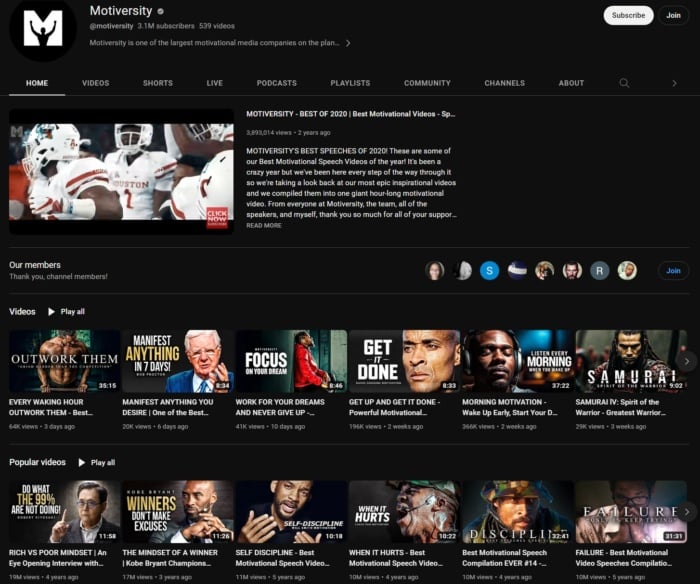
3. Entertaining Videos
You’re trying to get people to laugh or smile in this category.
Your content should intrigue them to investigate your brand further and create a positive experience they associate with your brand or product. Like this example from Dollar Shave Club:
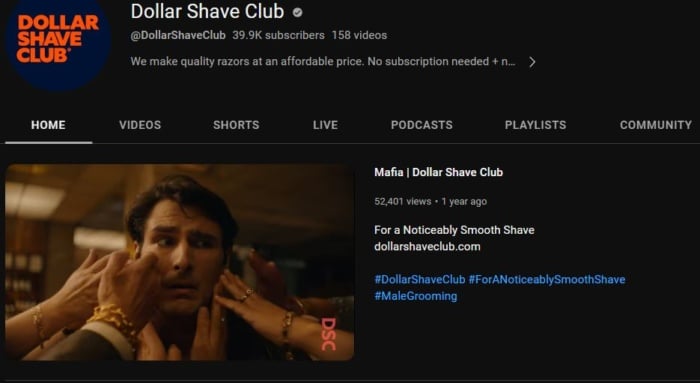
If you have no idea where to start: don’t worry; it’s not the end of the world.
Trialing content from each category helps you find your feet and gain audience insight.
As time passes, you’ll better understand what type of video content works and what doesn’t.
Trust me, if your audience wants a different type of video, they’ll ask for it.
Pay attention to your comments section! I certainly do.
3. Start Creating and Stop Holding Yourself Back
Okay, now that we’ve gotten all the planning out, it’s time to dive into the fun part.
I want to emphasize “fun” here because your video doesn’t have to be perfect.
It doesn’t even have to be great.
Just good enough is a fantastic start. Get your video marketing strategy underway and get your name out there.
Trust me. It’s only going to get easier. Your audience will be vocal about what they do and don’t like so that you won’t be stranded for long.
Once you hit “publish,” you start to get feedback. This feedback means you can make changes and adapt your video marketing strategy.
Don’t wait until you’ve invested in video marketing tools, either. If you’ve got a smartphone, you’ve got what it takes to start creating.
It might not be perfect (although their rapidly improving cameras certainly make a huge difference for low-budget marketers), and that’s absolutely okay.
It is that simple.
If you don’t want to be on screen, that’s fine. You don’t have to. You can use faceless videos for your YouTube marketing. All you need is some stock video and graphical footage with background music, captions, and a voiceover.
As for editing, you can use InVideo as your one-stop solution for video editing and customization.
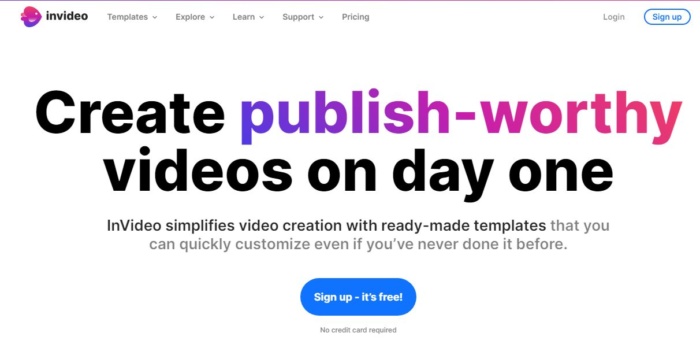
That’s all you need to start creating videos, so what are you waiting for?
4. Search Matters
I love discussing the creative process and useful tricks for video marketing. However, video SEO is the cornerstone of any truly effective video marketing strategy.
I know you might not want to hear it because it’s another item to consider. However, you’re missing out on free exposure if you don’t optimize your video for search.
SEO might seem scary. Don’t worry, though. You just need to avoid overcomplicating it.
Think of video marketing SEO in the same way you do for your blog.
You’d integrate keywords into your blog titles and descriptions, right? Do the same on YouTube (or any other video marketing platform you use).
You know those description sections under videos on YouTube? Google’s Algorithm trawls through them for its users. For high-performing video marketing through SEO, follow the same SEO best practices you would for written content. That means you should:
- Avoid keyword stuffing.
- Include relevant keywords.
- Do your research and get into the mindset of your customer.
Finally, balance storytelling and metrics. Maybe even consider getting a copywriter involved if you are unsure what to write.
See? Panic avoided!
5. Partner With Influencers
It wasn’t long ago that “celebrity endorsement”’ was something that only the world’s biggest brands could afford.
Smaller brands and local businesses could only sit back and watch athletes and actors use their mass appeal to help these businesses sell more products.
Then came the game changer.
Social media has helped even up the playing field. Don’t have the budget for an A-lister? That’s fine because micro-influencers are on the rise.
They have their loyal following and a unique understanding of how to appeal to the people in their industry.
Frankly, they can be pretty darn effective.
The best micro-influencers can run with your vision for content and provide you with unique and valuable insight into what would work best for their audience.
Plus, there’s no denying that having your brand presented to a group of anywhere from 100,000 to several million dedicated followers can be massively impactful.
For example, Off The Beaten Track sells women’s travel and casual shoes. It’s achieved significant success and is all down to its micro-influencer strategy. The brand works with 400 micro-influencers, which provides an annual reach of over 750,000 customers.

The company’s Creative Director, Kristina Petrick, says:
“Social media accounts for approximately 44 percent of our gross e-commerce revenue.”
Petrick added that these influencers create most of its content and assist brand exposure.
6. Use Ads to Their Full Potential
Don’t forget your previous marketing principles just because you’re trying video marketing. Use organic and paid traffic to maximize your ads. This is especially helpful if you’re new to video marketing.
Let’s take a look at the Facebook ads targeting mechanics.
Using Facebook, brands can easily tailor their ads to suit a variety of different users.
Your ads can target users based on key demographics such as their age, gender, location, interest, and much more.
Because of social media analysis, you’ll even know what your typical daily reach is.
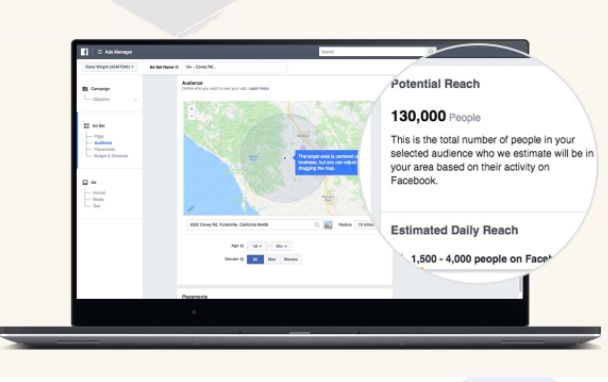
The best part?
You can customize each ad to maximize its relevance.
For example, let’s say that you created two videos.
The first video is for people getting ready to retire, and the second is for people who have just graduated college.
Instead of presenting your entire audience with an ad that likely won’t be very useful for them, you can ensure each video gets its own category and is presented to relevant parties.
When you increase the quality of your video marketing by ensuring your ads are targeted, you’ll inevitably convert more users into customers.
Of course, Facebook isn’t the only platform for running ads. From Instagram to TikTok and every social network in between, there are plenty of social media sites to choose from.
However, this raises an important question: where should you spend your money on ads?
Well, remember back in the first section when I mentioned that posting in various places would help you in the long term?
With this data, you can pinpoint where your content receives the most engagement.
From there, it’s as simple as having a higher ad budget on those platforms.
If your audience likes to consume your videos on Instagram, Instagram ads it is.
If they love Facebook, promote your content on Facebook.
Building Your Video Marketing Mastery
Building video marketing mastery skills is a must if you want to stay ahead of video marketing trends and reach out to new and current customers.
In this section, I explore some simple but vital steps to hone your video marketing skills and get the word out about your business.
7. Make Sure Your Videos Are Optimized
Want to make the most of your video marketing? Then optimization is a must.
Assuming you’ve selected the best platform for your audience, there are a few more areas you’ll want to focus on.
The first is using relevant keywords. Add them to your titles, descriptions, and tags. Doing this
helps search engines understand what your video is about and improve its chances of ranking higher in SERPs.
Another way is to optimize your video file name by adding your chosen keyword. As Hubspot explains, you can replace the “business_ad_003FINAL.mov” file with your keyword. When you’re uploading it, YouTube displays the filename, so here’s your chance to change it.
Spend some time on your thumbnails too. Just like meta descriptions in SERPs, thumbnails are the first thing people see when looking for videos. Make a custom thumbnail for a better chance of getting click-throughs. Here are a few examples of thumbnail design from popular videos on my YouTube channel:

Don’t forget promotion, either. Promoting your content is vital to video marketing optimization. You can start by sharing your video links across all your platforms. You may also want to create a specific page for videos on your website. This way, you can have your video content ranked in rich snippets for additional SEO.
Finally, don’t overlook transcripts. Including written transcripts makes it easier for search engines to understand your audio or video content. They can then serve relevant content to searchers.
8. Find The Platform That Makes Sense For You
Finding the right video platform for your business can seem challenging, but don’t worry. It’s not rocket science! There are a few things to consider when making your decision.
First, think about your target market. Who are you trying to reach? Different video platforms have different audiences, so choose one that caters to your audience’s interests and habits. Create a customer persona to narrow down your target market, if needed.
For example, consider using TikTok or Instagram if your target audience is primarily young adults. On the other hand, if your target audience is mostly professionals, LinkedIn might be a better choice.
Next, consider your budget. While the likes of YouTube and TikTok are free for basic video marketing, you have to pay for ads. If you decide to run paid ads, determine how much money you want to spend and choose a platform that aligns with your budget.
Lastly, check out what your competitors are doing. What video platforms are they using? What types of videos are they creating? Analyzing your competition can give you insight into what works and doesn’t in your industry.
Test your results over time to see what works, then adapt your video marketing strategy if needed.
9. Find Ways To Work AI Into Your Video Creation
There’s no getting away from it, is there? AI is everywhere you look these days. That’s definitely true for video marketing. Numerous tools are available now, all designed to enhance quality and improve productivity.
The most obvious area is to use AI for video creation. For instance, Vidyard allows you to create an hour-long or shorter video. It works through a free Chrome extension and also lets you share videos in emails.
Additionally, you can optimize for SEO, automatically transcribe your videos, access analytics, and more.
Idomoo offers AI-powered video personalization to help you make the most of your customer data.
It has a ChatGPT video plug-in allowing real-time AI video generation to simplify sharing and language.
Then, Pictory enables you to repurpose long-form content and transform it into videos. It’s described as a “Complete Video Marketing Toolkit.” It has numerous other features, including video transcriptions and captions.
Next up, you’ll want some tools for video editing. Magisto has video editing and making features, allowing video creation automation. It’s got a ton of templates, and you can also brand your videos, too.
Synthesia lets you create and edit videos from text. It also enables automated video creation by analyzing your written content. It also provides templates, avatars, AI voices and languages, and avatars.
Adobe Premiere Pro has a range of AI tools to boost your video editing efficiency, like color match and auto reframe.
If you want to dive deeper into video analytics, give Sprout Video a look. In addition to an extensive range of video marketing tools, Sprout Video can:
- Tell you who is watching your videos and live streams
- Help identify drop-off points to you can strengthen your content
- Send targeting campaigns.
You can sign up for a free trial to get started.
Some other AI video creation tools that you can explore include:
- Adobe Sensei – Adobe’s AI technology offers a range of video editing and analysis tools.
- Rocketium – An AI-powered tool that allows video creation and collaboration.
- Vimeo allows one-take video creation for social, marketing, and seasonal occasions, etc.
Next up, it’s time to promote the video marketing content you’ve created.
10. Have A Promotion Plan For Video Marketing Content
The key to a successful promotional plan is to cast a wide net and leverage multiple channels to get your content in front of your ideal audience. With a bit of creativity and persistence, you can create a plan that drives traffic, engagement, and conversions.
Here are some steps to get you started.
Your first step to video marketing promotion is getting social. Ensure you share your videos on all your social media channels, including Facebook, TikTok, Twitter, and Instagram. If you’re targeting a B2B audience, then try LinkedIn.
You can also create teasers to grab people’s attention and link back to the full video.
Don’t forget about email. It’s a powerful promotional tool with a 21.5 percent open rate.
Send an email blast to your subscribers announcing your new video and include a link to watch it. You can also incentivize them to share it with their friends by offering a special promotion or discount code for doing so.
I’ve already mentioned influencers, but I must mention them again here.
Collaborating with influencers is a fantastic way to reach new audiences. Find influencers in your niche and ask them if they can share your video with their followers. You can either pay them or offer them a commission. Just ensure the influencer is clear they’re receiving compensation.
Another technique is pay-per-click ads. This can get your videos out to a wider audience and better target your audience. You can use services like YouTube marketing Ads, Facebook Ads, or Google Ads to target specific demographics, interests, and locations.
All this promotion is one thing. However, you’ll also need to track metrics to reap the benefits of video marketing.
11. Find The Metrics You Will Track For Success
You don’t know how effective your video marketing is if you’re not tracking it. Here are some metrics to keep a keen eye on:
1. View Count: This one is simple. It’s just the number of views your video gets. It’s a good starting point to see how far your video has reached, but don’t get too caught up in it.
2. Engagement: Tracks the likes, comments, shares, and other interactions your video receives. It gives you an idea of how your video resonates with your audience and whether it’s generating a conversation.
3. Conversion Rate: Tells you how many people take a specific action after watching your video, like filling out a form or making a purchase.
4. Click-Through Rate (CTR): Shows how many people click through to your website or another landing page from your video content.
5. Play Rate: This metric tracks the percentage of viewers who click play on your video.
6. Watch Time: Shows how long viewers spend watching your video. It tells you which parts of your video are most engaging and where people might be dropping off.
7. ROI: This one’s all about the return on investment from your video marketing campaigns. It measures how much revenue your videos generate compared to the cost of producing and promoting them.
By consistently monitoring and analyzing these metrics, you can gain greater insight into the performance of your videos and make data-driven decisions to optimize your video marketing campaigns.
12. Be Ready To Adapt Your Strategy As Needed
Are you looking to keep up with the ever-evolving market and ensure your videos hit the mark with your intended audience? Adapting your video marketing strategy can help you do just that.
Factors such as changes in audience preferences, technological advancements, and market shifts can all impact your videos’ performance. Adapting your video marketing strategy allows you to stay ahead of the competition, respond to emerging trends, and optimize your campaigns to achieve better results.
There isn’t a set rule on when to consider changing your video marketing strategy, as it largely depends on your specific goals and situation. However, here are some scenarios where you might consider changing things up:
1. Poor performance: If your videos aren’t generating the desired results, like engagement or conversions, it’s time to look closely at your strategy.
2. Shifts in target audience: If your audience is shifting, you need to adjust your video content to better suit their interests.
3. Emergence of new technology: If new technology can help boost your video performance, it’s important to consider implementing it into your strategy.
4. Changes in market trends: If your industry experiences significant changes, your videos may no longer be relevant or effective, and you may need to shift your video marketing strategy to stay competitive.
5. Competitor activity: If your competitors are implementing more successful video marketing strategies, it’s time to adapt and adjust your own strategy to stay in the game.
Remember, it’s important to be flexible and willing to change your video marketing strategy to ensure your videos always hit the mark.
By keeping an eye on your metrics, staying up-to-date with trends, and frequently evaluating your strategy, you can stay ahead of the curve and succeed with your video marketing campaigns!
FAQs
Video marketing is using video to promote a product, service, or message.
Ideally, when you draw up a video marketing strategy, you want to develop entertaining, engaging, and educational ideas to drive leads and increase engagement.
Because it works!
Apart from the engagement and convenience video marketing offers, there are other reasons you’d want to consider using it.
Video marketing provides flexibility with the types of content you can make (explainers, demos, testimonials, etc.)
Additionally, it allows viewers to feel like they know you a little better. In turn, that leads to increased trust and credibility.
Then there’s the sheer choice of platforms, like YouTube and TikTok, with millions of potential prospects.
Why do so many marketers favor this form of marketing? Because video marketing enhances SEO, it’s versatile, memorable, and a fantastic way to tell your story.
These are just some of the benefits of video marketing. I could go on, but that gives you an idea of what makes it such an effective technique.
You should consider using video marketing to get your message out to a vast audience. It fits people’s business lifestyles and allows them to consume content on the go.
Video marketing is also hard to beat when it comes to engagement and getting your message out there.
Judging by the numerous stats out there, extremely! According to Hubspot’s State of Video Marketing report, 91 percent of marketers use video marketing. They say it gives them enhanced dwell time, leads, traffic, sales, and reduced consumer queries.
Additionally, Hubspot says video marketing remains integral to their “journey with brands.” Therefore, customers expect brands to produce videos that help inform their research and purchase decisions.
Conclusion
I won’t give you the impression that video marketing is easy. It’s tough, and it challenges you.
Creating compelling content can sometimes be an uphill battle, particularly when starting.
Your first video isn’t going to be amazing, which is totally okay!
Leave perfection to the artists. Out here in the marketing world, I’ll settle for meaningful progress.
Come up with a video marketing strategy, and then execute that strategy by creating content as soon as you can. Measure your results, and take advantage of the (free) platforms and resources at your disposal.
Video marketing may not be an easy way to build your brand, but once you get the hang of it, you’ll wonder why you waited this long to get started.
It’s time to add video marketing to your content strategy.
If you’ve already experimented with video marketing, what’s working for you?

See How My Agency Can Drive More Traffic to Your Website
- SEO - unlock more SEO traffic. See real results.
- Content Marketing - our team creates epic content that will get shared, get links, and attract traffic.
- Paid Media - effective paid strategies with clear ROI.
Are You Using Google Ads? Try Our FREE Ads Grader!
Stop wasting money and unlock the hidden potential of your advertising.
- Discover the power of intentional advertising.
- Reach your ideal target audience.
- Maximize ad spend efficiency.

